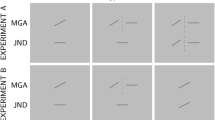Abstract
The motor control of pointing and reaching-to-grasp movements was investigated using two different approaches (kinematic and modelling) in order to establish whether the type of control varies according to modifications of arm kinematics. Kinematic analysis of arm movements was performed on subjects' hand trajectories directed to large and small stimuli located at two different distances. The subjects were required either to grasp and to point to each stimulus. The kinematics of the subsequent movement, during which subject's hand came back to the starting position, were also studied. For both movements, kinematic analysis was performed on hand linear trajectories as well as on joint angular trajectories of shoulder and elbow. The second approach consisted in the parametric identification of the black box (ARMAX) model of the controller driving the arm movement. Such controller is hypothesized to work for the correct execution of the motor act. The order of the controller ARMAX model was analyzed with respect to the different experimental conditions (distal task, stimulus size and distance). Results from kinematic analysis showed that target distance and size influenced kinematic parameters both of angular and linear displacements. Nevertheless, the structure of the motor program was found to remain constant with distane and distal task, while it varied with precision requirements due to stimulus size. The estimated model order of the controller confirmed the invariance of the control law with regard to movement amplitude, whereas it was sensitive to target size.
Similar content being viewed by others
References
Akaike H (1972) A new look at the statistical model identification. IEEE Trans Autom Contr 19:713–723
Astrom KJ (1980) Maximum likelihood and prediction error methods. Automatica, 16:551–574
Box GEP, Jenkins GM (1970) Time series analysis, forecasting and control. Holdern-Day, San Erancisco
Carter MC, Shapiro DC (1984) Control of sequential movements. J Neurophysiol 52:787–796
Chalam VV (1987) Adaptive control systems. Techniques and applications. Dekker, New York
D'Amico M, Ferrigno G (1990) A technique for the evaluation of derivatives from noisy biomechanical displacement data by a model-based bandwith-selection procedure. Med Biol Eng Comput 28:407–415
Drillis R, Contini R (1972) Body segments parameters. Tech. Rep. 1166.03 New York University, School of Engineering and Science, Research Div., New York
Ferrigno G, Pedotti A (1985) ELITE: a digital dedicated hardware system for movement analysis via real-time TV signal processing. IEEE Trans Biomed Eng BME-32, 11:943–950
Fitts PM (1954) The information capacity of the human motor system in controlling the amplitude of movement. J Exp Psychol 47:381–391
Gentilucci M, Castiello U, Corradini ML, Scarpa M, Umilta' C, Rizzolatti G (1991) Influence of different types of grasping on the transport component of prehension movements. Neuropsychologia, 29:361–368
Gentilucci M, Chieffi S, Scarpa M, Castiello U (1992) Temporal coupling between transport and grasp components of prehension movements: effects of visual perturbation. Behav Brain Res 47:71–82
Goodale MA, Pelisson D, Prablanc C (1986) Large adjustments in visually guided reaching do not depend on vision of the hand of or perception of target displacement. Nature 320:748–750
Hoff B, Arbib MA (in press) A model of the effects of speed, accuracy and perturbation on visually guided reaching. In: Caminiti R (ed.) Control of arm movement in space: neurophysiological and computational approaches. Exp Brain Res [Suppl] Series
Jeannerod M (1988) The neural and behavioral organization of goal-directed movements. Clarendon Press, Oxford
Landau YD (1979) Adaptive control. Dekker, New York
Ljung L (1986) System identification — theory for the user. Prentice Hall, Englewood Cliffs, NJ
Ljung L, Soderstrom T (1983) Theory and practice of recursive identification. MIT Press, Cambridge
Ljung L, Gustavsson I, Soderstrom T (1974) Identification of linear multivariable systems operating under linear feedback control. IEEE Trans Autom Contr, AC-19, 6:836–840
Marteniuk RG, MacKenzie CL, Jeannerod M, Athenes S, Dugas C (1987) Constraints on human arm trajectories. Can J Psychol 41:365–378
MacKenzie CL, Marteniuk RG, Dugas C, Liske D, Eickmeir B (1987) Three dimensional movement trajectories in Fitts' law: Implication for control. QJ Exp Psychol 39:629–647
Megaw ED (1984) Possible modification to a rapid on-going programmed manual response. Brain Res 71:425–441
Paulignan Y, MacKenzie C, Marteniuk R, Jennerod M (1990) The coupling of arm and finger movements during prehension. Exp Brain Res 79:431–435
Paulignan Y, MacKenzie C, Marteniuk R, Jeannerod M (1991) Selective perturbation of visual input during prehension movements. 1. The effects of changing position. Exp Brain Res 83:502–512
Rizzolatti G, Camarda R, Fogassi L, Gentilucci M, Luppino G, Matelli M (1988) Functional organization of inferior area 6 in the macaque monkey. Area F5 and the control of distal movements. Exp Brain Res 71:491–507
Schmidt RA (1988) Motor control and learning: a behavioral emphasis. Hum Kinet, Champain, Ill
Soechting JF (1984) Effect of target size on spatial and temporal characteristics of a pointing movement in man. Exp Brain Res 54:121–132
Soechting JF, Lacquaniti F (1983) Modification of trajectory of a pointing movement in response to a change in target location. J Neurophysiol 49:2,548–564
Viviani V, Terzuolo C (1981) Space-time invariance in learned motor skill. In Stelmach GE, Requin J (eds.) Tutorial in motor behavior. North-Holland, Amsterdam, pp 525–533
Woodsworth RS (1899) The accuracy of voluntary movements. Psychol Res Monogr [Suppl] 3:1–114
Author information
Authors and Affiliations
Rights and permissions
About this article
Cite this article
Corradini, M.L., Gentilucci, M., Leo, T. et al. Motor control of voluntary arm movements. Biol. Cybern. 67, 347–360 (1992). https://doi.org/10.1007/BF02414890
Received:
Accepted:
Issue Date:
DOI: https://doi.org/10.1007/BF02414890




